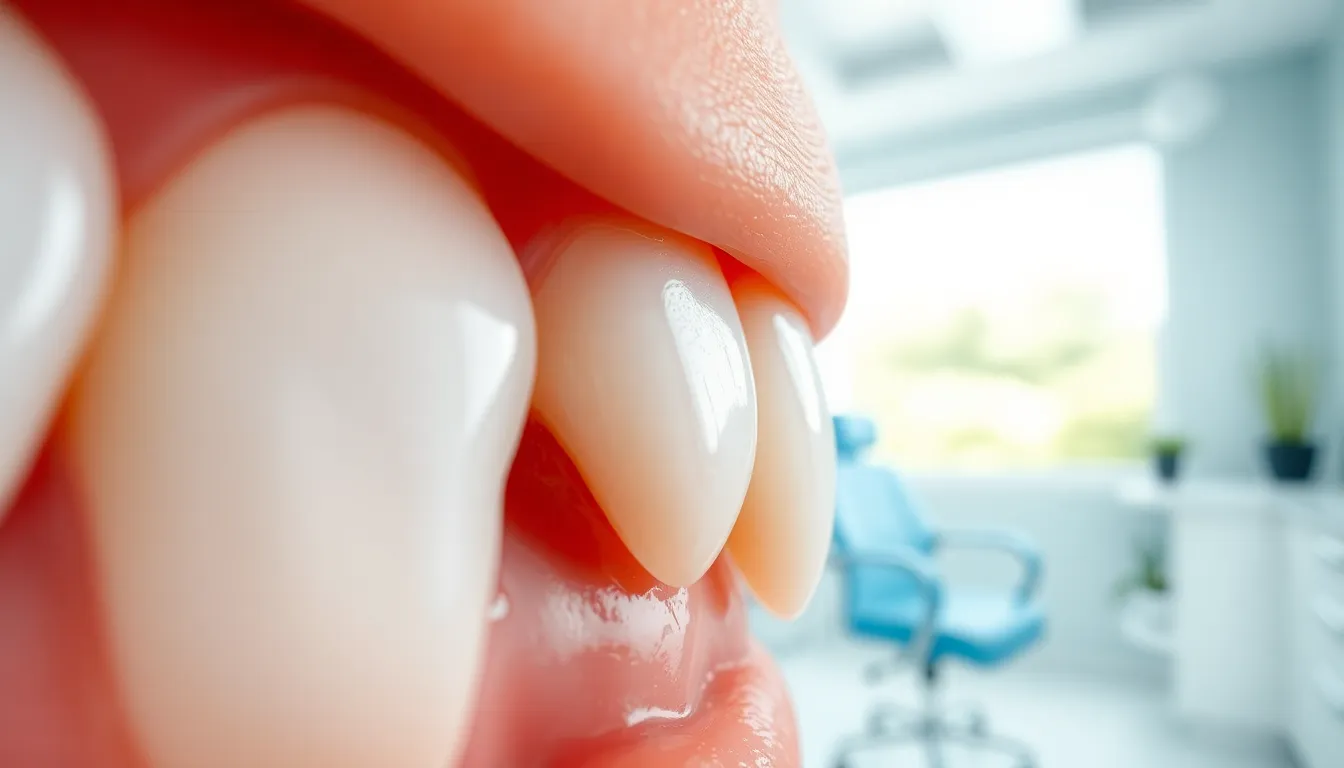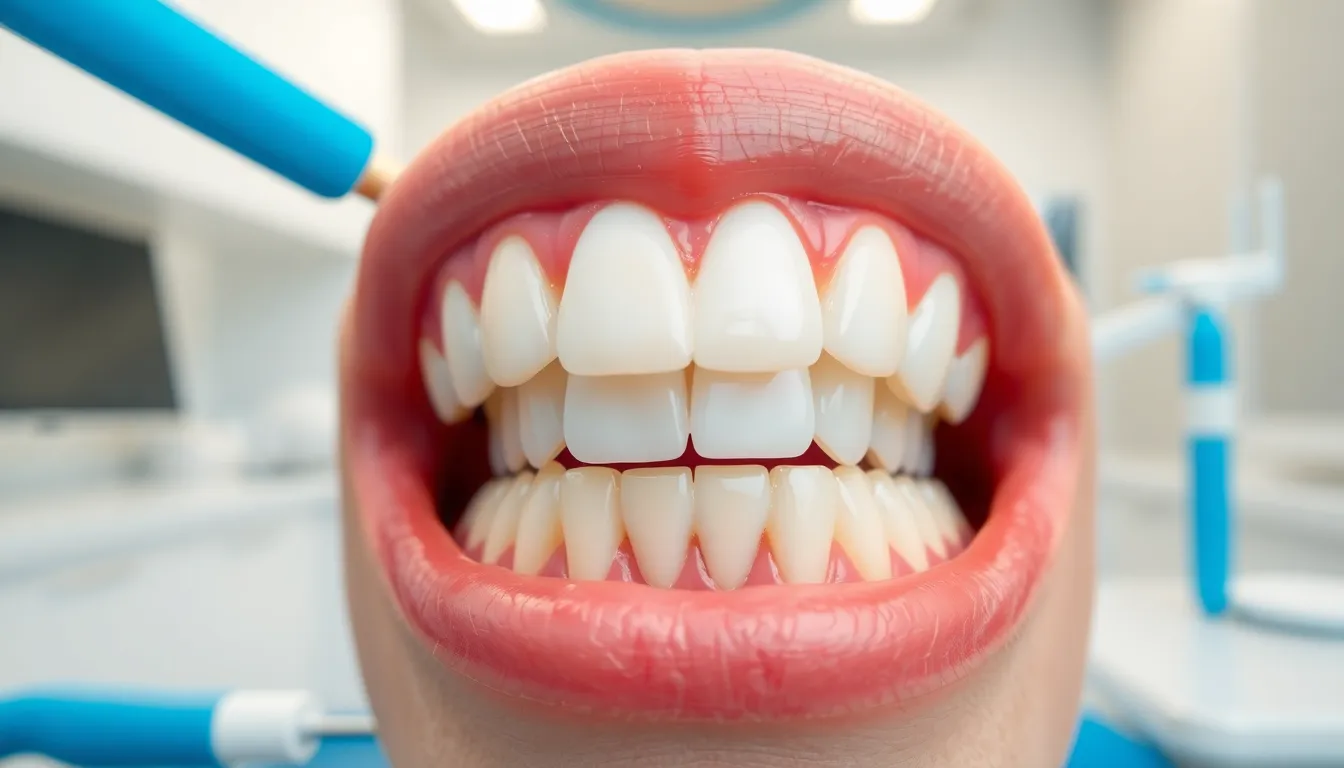Ever wondered what that tiny groove between your gums and teeth is called? That’s your dental sulcus, a critical yet often overlooked part of your oral anatomy that plays a vital role in your overall dental health.
Your dental sulcus serves as a protective moat around each tooth, creating a small space where your gum tissue meets your tooth surface. When healthy, this groove measures between 1-3 millimeters deep. But, when plaque builds up in this area, it can lead to inflammation, deepening of the sulcus, and eventually periodontal disease. Understanding and properly caring for this small space is essential for maintaining healthy teeth and preventing serious dental issues.
What Are Sulcus Teeth?
Sulcus teeth refer to teeth surrounded by the dental sulcus, which is the small groove or space between your tooth and the surrounding gum tissue. This natural pocket forms a protective barrier around each tooth and plays a critical role in maintaining oral health.
Anatomy of Tooth Sulcus
The tooth sulcus consists of several key anatomical components that work together to protect your teeth. This shallow groove typically measures between 1-3 millimeters in healthy individuals and creates a cuff-like structure where the gum meets the tooth surface. Inside the sulcus, you’ll find crevicular fluid that contains immune cells and proteins which help fight bacteria and protect the underlying tissues. The epithelial lining of the sulcus serves as a defensive barrier against bacterial invasion while allowing necessary nutrients to reach the tooth.
Dr. Harris often explains to patients: “Think of your sulcus as a moat around a castle. When it’s the right depth and clean, it protects the foundation of your tooth. But when debris accumulates, that protection weakens.”
Common Locations of Sulcus
The dental sulcus surrounds every tooth in your mouth, forming a continuous channel around the circumference of each tooth at the gumline. This sulcus is present on both the facial (outer) and lingual (inner) surfaces of your teeth. The depth of the sulcus varies throughout your mouth, with posterior teeth (molars and premolars) often having slightly deeper sulci compared to anterior teeth (incisors and canines). These variations occur due to differences in tooth morphology and gum architecture across different areas of the dental arch.
Causes of Sulcus Formation in Teeth

The gingival sulcus naturally forms as the small V-shaped groove where your gum tissue meets the tooth surface. While this space exists in everyone’s mouth, various factors influence its depth and health, potentially transforming a normal sulcus into a problematic periodontal pocket.
Genetic Factors
Genetics significantly impact your susceptibility to periodontal conditions that affect sulcus health. Your inherited traits can influence immune responses, gum tissue characteristics, and the structural integrity of periodontal attachments. Family history often predicts vulnerability to gum diseases like gingivitis and periodontitis, which directly affect sulcus depth. Though research hasn’t identified exact genes responsible for naturally deeper sulci, genetic predisposition clearly plays a role in how your body responds to oral bacteria and inflammation.
“I’ve treated multiple members of the same family with similar periodontal issues,” notes Dr. Todd B. Harris. “One patient discovered her genetic predisposition to periodontitis only after her sister experienced severe gum recession. This knowledge allowed us to carry out an aggressive preventive strategy that’s helped maintain her sulcus health.”
Environmental Influences
Environmental factors constitute the primary contributors to changes in your gingival sulcus:
- Plaque and Tartar Accumulation: Inadequate oral hygiene leads to bacterial plaque buildup within the sulcus, which hardens into tartar. This persistent irritation causes gum inflammation and sulcus deepening.
- Inflammatory Gum Diseases: Bacterial infection in the sulcus initially causes gingivitis, characterized by redness and bleeding. Left untreated, this inflammation progresses to periodontitis, creating pathological pockets exceeding 4mm in depth, resulting in gum recession and tooth mobility.
- Medication Effects: Certain medications, particularly those for seizures, hypertension, and immunosuppression, can cause gingival hyperplasia. This overgrowth of gum tissue alters sulcus depth and compromises proper cleaning.
- Lifestyle Factors: Smoking dramatically increases risk for sulcus deepening by restricting blood flow to gum tissues and impairing immune function. Diabetes similarly affects sulcus health by compromising circulation and healing.
Environmental influences typically work in combination rather than isolation. For example, a patient with poor oral hygiene who also smokes faces significantly higher risks for sulcus deterioration than someone with just one risk factor.
Health Implications of Sulcus Teeth

The gingival sulcus significantly impacts your overall oral health, serving as a potential site for bacterial accumulation when not properly maintained. Understanding the health implications of this small groove between your teeth and gums can help you prevent serious dental problems.
Increased Risk of Cavities
Plaque tends to accumulate in the gingival sulcus, creating an ideal environment for cavity development, particularly near or below the gum line. Bacteria in this area produce acids that erode tooth enamel, eventually leading to decay that affects both the tooth structure and surrounding gum tissue. Infections from these cavities can cause pus formation, resulting in painful symptoms including toothache, sensitivity to temperature extremes, and visible holes or black spots on affected teeth.
Dr. Todd B. Harris often shares with patients, “I’ve seen many cases where patients maintain excellent brushing habits on the visible surfaces of their teeth but neglect the sulcus area. One patient came in with perfectly white, seemingly healthy teeth, but had developed multiple cavities along the gum line simply because they weren’t cleaning this crucial pocket effectively.”
Gum Disease Concerns
Food debris and bacterial plaque trapped in the sulcus trigger inflammatory responses in your gum tissue, initially causing gingivitis characterized by red, swollen, and bleeding gums. Left untreated, this inflammation progresses to periodontitis, destroying the supporting structures of your teeth including soft tissue and bone. The healthy gingival sulcus measures 3 millimeters or less, allowing effective cleaning with regular oral hygiene practices. Deeper sulci create protected environments for harmful bacteria, significantly complicating cleaning efforts and accelerating disease progression.
Gingival hyperplasia, an overgrowth of gum tissue often associated with poor oral hygiene or medication side effects, can develop around the sulcus area. This condition impairs normal tooth alignment and dramatically increases your risk of developing serious periodontal disease. Regular monitoring of sulcus depth during dental checkups provides valuable insight into your gum health status, as increasing measurements often indicate progressive disease requiring prompt intervention.
Proper Care for Sulcus Teeth

Maintaining a healthy gingival sulcus requires consistent attention to prevent plaque buildup and inflammation. The ideal sulcus depth measures 3 millimeters or less, with deeper measurements potentially indicating gum disease. Healthy gums appear firm and pink or light brown, fitting snugly around your teeth.
Specialized Cleaning Techniques
Effective sulcus cleaning techniques protect this crucial space between your teeth and gums from bacterial invasion. Brushing along the gumline with gentle yet thorough motions removes plaque without causing trauma to delicate gum tissue. Daily flossing reaches areas where toothbrushes can’t access, clearing debris and bacteria from the sulcus. Regular professional cleanings at your dentist’s office help measure sulcus depth and remove hardened tartar from below the gumline, preventing periodontal disease progression.
Dr. Harris often tells patients, “Think of your daily oral care routine as preventive maintenance for your mouth’s natural defense system. One patient who improved her sulcus cleaning technique saw her gum inflammation disappear within two weeks.”
Recommended Dental Tools
Exact dental tools make sulcus maintenance more effective and comfortable. Soft-bristled toothbrushes clean the gumline without causing gum recession or enamel wear. Dental floss or interdental brushes reach between teeth and into the sulcus to remove plaque and food particles that brushing alone misses. Antimicrobial mouth rinses reduce bacteria in the sulcus area, supporting overall gum health between cleanings. During checkups, dental professionals use specialized sulcus probes to accurately measure the depth of these spaces, detecting early signs of periodontal issues before they become serious.
Treatment Options for Problematic Sulcus

When your gingival sulcus becomes problematic, several effective treatments can restore its health and function. These interventions target different aspects of sulcus health, from preventing bacterial invasion to repairing damage caused by periodontal disease.
Dental Sealants
Dental sealants serve as protective barriers applied to the grooves of teeth, primarily molars, preventing bacterial invasion and tooth decay. These thin coatings effectively seal the pits and fissures near the sulcus area, reducing plaque accumulation and protecting against harmful bacteria colonization. Patients with deep grooves benefit significantly from sealants as these areas often trap food particles and encourage biofilm formation. Dr. Harris notes, “Many of my patients with recurring issues around their molar sulcus have seen dramatic improvements after sealant application, particularly those with anatomically deeper grooves.”
Restorative Procedures
Restorative treatments become necessary when your sulcus has been compromised by disease leading to tissue destruction or cavity formation. Professional cleaning and scaling remove plaque and calculus from the sulcus, preventing further deterioration of the tooth-gum interface. Advanced cases might require periodontal surgery to reduce sulcus depth from greater than 3mm to a more manageable and cleanable depth. Dental restorations including fillings, crowns, or other interventions repair damaged tooth surfaces adjacent to the sulcus, creating smoother contours that discourage bacterial adhesion. The primary goal of these procedures focuses on restoring healthy anatomy and facilitating proper cleaning to halt disease progression and prevent tooth loss.
When to See a Dentist About Tooth Sulcus

Warning Signs of Deepening Sulcus
Dental attention is necessary when your gingival sulcus depth exceeds 3 to 4 millimeters, as this measurement indicates potential gum disease. Measuring tools used by dentists during regular checkups help detect these changes early before they progress. Bleeding gums during brushing or flossing often signal inflammation in the sulcus area where bacteria have accumulated. Food frequently getting trapped between your teeth and gums might suggest a deepening sulcus that’s creating more space for debris.
“I recently had a patient who ignored persistent bleeding while flossing for months,” shares Dr. Todd B. Harris. “By the time she came in, her 2mm sulcus had deepened to 5mm in several areas, requiring extensive treatment that could have been avoided with earlier intervention.”
Consequences of Untreated Deep Sulcus
Deeper sulcus areas trap harmful bacteria and food particles, forming biofilm that damages the soft tissues and periodontal fibers connecting your gums to teeth. These bacterial colonies contribute to accelerated tissue destruction if left unchecked. Progression from a normal sulcus to a periodontal pocket occurs when the depth continues to increase beyond 4mm, creating spaces bacteria can thrive in. Gum recession typically follows as the deepened sulcus leads to destruction of supporting tissues around your teeth.
Bone loss becomes inevitable when a deep sulcus remains untreated, as bacteria extend their destruction to the underlying alveolar bone. Tooth mobility increases as supporting structures deteriorate, making everyday activities like chewing uncomfortable or painful. Complete tooth loss represents the final stage of this progressive condition when intervention comes too late.
Professional Evaluation and Treatment
Your dentist divides the mouth into six sections (sextants) during examination: upper right, upper anterior, upper left, lower right, lower anterior, and lower left. This systematic approach ensures thorough evaluation of sulcus depth throughout your mouth. Dental professionals use specialized probes to gently measure the space between your gums and teeth, recording measurements at multiple points around each tooth.
Treatment plans vary based on the severity of sulcus deepening, ranging from improved home care instructions to professional cleaning procedures. Referrals to periodontists become necessary for advanced cases where specialized interventions like scaling and root planing or surgical procedures are required. Regular follow-up appointments allow your dental team to monitor improvements in sulcus depth and adjust treatment approaches accordingly.
Early intervention dramatically improves outcomes for patients with deepening sulcus, preventing irreversible damage to supporting structures. Dental professionals emphasize that maintaining your regularly scheduled checkups every six months provides the best opportunity to detect and address changes in sulcus depth before they lead to serious complications.
Conclusion
Your dental sulcus plays a vital role in your overall oral health. This small groove between your teeth and gums serves as a protective barrier that requires consistent care and attention. By understanding the anatomy factors affecting its health and warning signs of problems you’re empowered to take proactive steps.
Remember that proper brushing flossing and regular dental visits are your best defense against sulcus-related issues. Don’t wait until you experience symptoms like bleeding gums or food trapping to seek professional help.
Protecting your sulcus means protecting your smile for years to come. With the right knowledge and consistent care you’ll maintain this crucial dental feature and enjoy better oral health throughout your life.
Frequently Asked Questions
What is a dental sulcus?
A dental sulcus is a small groove or space between your gums and teeth. It forms a protective barrier around each tooth and should ideally measure 1-3 millimeters deep. This space contains crevicular fluid with immune cells that help combat bacteria. Think of it as a moat around a castle (your tooth) that provides protection when properly maintained.
Why is the dental sulcus important?
The dental sulcus is crucial for oral health because it creates a protective barrier around each tooth. It contains crevicular fluid with immune cells and proteins that fight bacteria. When healthy, it prevents bacterial invasion that could lead to gum disease and tooth decay. However, if neglected, it can become a collection site for plaque and bacteria, potentially leading to periodontal disease.
How deep should a healthy dental sulcus be?
A healthy dental sulcus typically measures between 1-3 millimeters deep. Depths exceeding 3-4 millimeters may indicate the beginning of periodontal disease. Posterior teeth (molars and premolars) naturally have slightly deeper sulci than anterior teeth (incisors and canines). Your dentist will measure these depths during regular checkups to monitor your gum health.
What causes changes in sulcus depth?
Several factors can affect sulcus depth, including genetic predisposition, plaque accumulation, inflammatory gum diseases, certain medications, and lifestyle factors like smoking and diabetes. Poor oral hygiene is the primary cause of increased sulcus depth as it allows plaque to build up, leading to inflammation and potential periodontal pocket formation.
How can I keep my dental sulcus healthy?
Maintain a healthy dental sulcus by brushing twice daily with a soft-bristled toothbrush, angling it toward the gumline. Floss daily to remove debris between teeth and below the gumline. Consider using antimicrobial mouth rinses for additional protection. Schedule regular dental cleanings every six months for professional removal of plaque and tartar and to monitor sulcus depth.
What happens if my dental sulcus becomes unhealthy?
An unhealthy dental sulcus can lead to several problems. Bacteria can accumulate, increasing the risk of cavities near the gumline. Inflammation can progress from gingivitis to periodontitis, causing the sulcus to deepen into a periodontal pocket. This can result in gum recession, bone loss, and eventually tooth loss if left untreated.
When should I see a dentist about my dental sulcus?
See a dentist if you notice bleeding gums when brushing or flossing, food frequently getting trapped between teeth and gums, persistent bad breath, receding gums, or teeth that feel loose. These symptoms may indicate issues with your dental sulcus. Regular dental checkups every six months are essential for monitoring sulcus health and detecting problems early.
What treatments are available for problematic dental sulcus?
Treatments for problematic dental sulcus include professional deep cleaning (scaling and root planing) to remove bacteria and calculus from below the gumline. Dental sealants may be applied to protect vulnerable areas. In advanced cases, periodontal surgery might be necessary to reduce pocket depth. The goal is to restore healthy anatomy and prevent disease progression.







